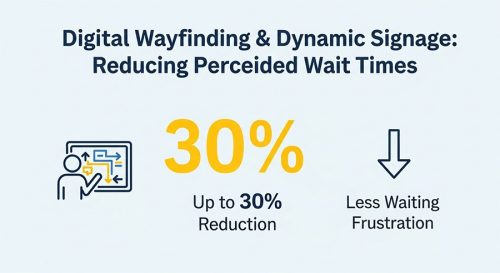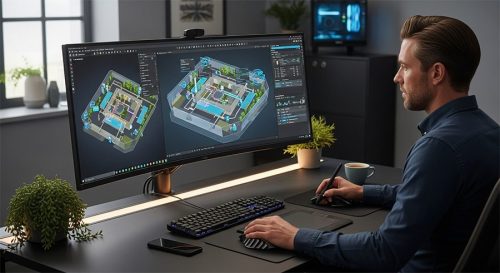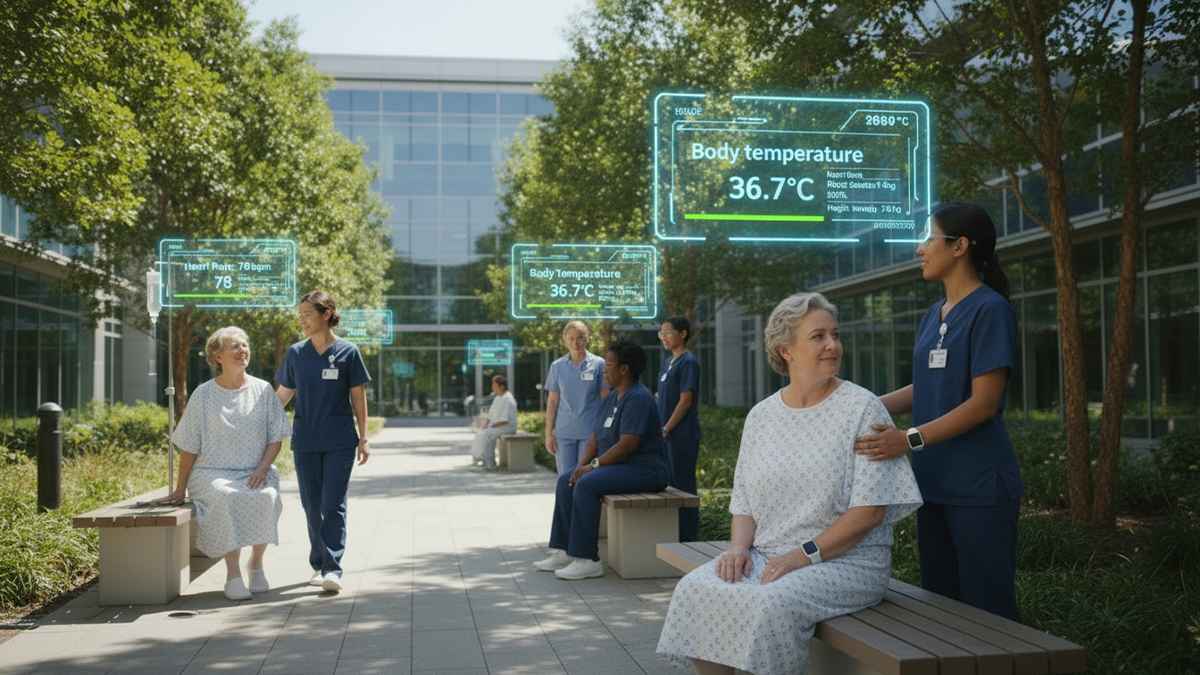
- Why Traditional Navigation Fails
- What Is Digital Wayfinding and Why It's the Future of Smart Navigation
- Examining the Technology Behind Seamless Navigation
- Benefits of Digital Wayfinding for Enterprises
- In Which Industries Does Digital Wayfinding Deliver the Most Impact
- How Can Immersive and Intelligent Design Transform Digital Wayfinding?
- How Immexive Deploys Digital Wayfinding Solutions
Large, complex organizations in various industries struggle with visitor navigation challenges across their facilities. By opting for digital wayfinding solutions, managers of such businesses can address related issues effectively and also experience significant improvements in performance metrics. A study published on ScienceDirect reports that 87% of respondents saw reduced wayfinding time since the deployment of this intelligent routing infrastructure. This highlights the effectiveness of the advanced technologies discussed below.
In this blog, we’ll examine the modern navigation system closely and explore the advantages it offers to all involved parties, including visitors, employees, and top-tier managers. If you want to upgrade your business and benefit in both the short and long term, continue reading.
Key Points:
- Traditional wayfinding systems cause confusion, lost productivity, and even financial losses of up to $50 billion annually for physical businesses.
- Poor navigation negatively impacts user experience, employee morale, and brand perception in large, complex facilities.
- Digital wayfinding replaces static maps with real-time, data-driven, and interactive navigation tools powered by AR, AI, and IoT.
- These systems enhance efficiency and accessibility by reducing navigation time, staff workload, and visitor frustration.
- Enterprises benefit through improved brand engagement and valuable data intelligence gathered from user interactions.
Why Traditional Navigation Fails
A blog post on Crowdconnected says that US brick-and-mortar businesses might be missing up to $50 billion annually due to shoppers’ difficulty finding what they need. This is a costly drawback of the traditional wayfinding approach, which is outdated in the modern era. Static signage and maps are less helpful in guiding visitors, or even staff, in large, complex buildings, leading to wandering and difficulties in finding locations. This is the primary reason legacy navigation systems fail.

Thus, navigation challenges in large buildings are severely harmful for brand perception and can easily damage a business’s reputation. Let’s look at more statistics that support the claim that the traditional wayfinding is irrelevant.
A US survey published in PubMed of 301 hospital staff indicates that each clinical staff member spends approximately 30 minutes per week helping patients and their companions find their way. Additionally, 44% of this statistical population report that frustrated visitors behave rudely toward them, due to confusion and indoor signage problems.
The same blog on Crowdconnected, which we referred to earlier in this section, states that each hospital employee spends around 4,500 hours annually giving directions to others or struggling to find their own way through the large building. This results in an annual loss of around $220k.
Visitors to large healthcare complexes for the first time often have trouble finding their appointment location due to poor conventional signage. According to Stratus, more than 85% of patients ask for directions, which not only congests employees’ time, but also increases the likelihood of missing the appointment.
The same blog also reports that around 30% of first-time visitors get lost and can’t reach their destination on time. Therefore, clinics lose approximately $200k per year due to inefficiencies in the classic wayfinding approach.
Although all these stats are from hospitals and the healthcare industry, the issue also affects large workplaces and offices across diverse industries. Comparing traditional wayfinding vs digital wayfinding, it’s clear that the former will lead to measurable inefficiencies, damaging businesses’ overall performance.
The loss is significant, and businesses should plan for an immediate practical solution: adopting digital wayfinding.
What Is Digital Wayfinding and Why It’s the Future of Smart Navigation
Unlike static signage, digital wayfinding is a fully dynamic approach that guides visitors by leveraging real-time data. Using interactive displays, mobile smart navigation, and real-time positioning, such systems help people navigate while considering crowd levels, wait times, and accessibility options.
Mapping, sensors, and data analytics are primary components of this modern navigation system, providing a personalized experience for each visitor with a high level of interactivity. In contrast to traditional wayfinding, modern alternatives are less likely to become outdated, since information changes instantly, resulting in fewer dissatisfied users.
Because interactive wayfinding systems don’t have the drawbacks of a conventional navigation approach, they offer numerous advantages for both visitors and staff. The primary benefit is reduced navigation time, which decreases frustration and employee burnout and lowers the number of missed appointments, which, as explained earlier, leads to financial losses.
Moreover, the fewer navigational challenges, the less perceived wait time for patients. Specifically, Wavetec reports that digital wayfinding solutions and dynamic signage can reduce perceived wait time by up to 30%, thereby increasing patient satisfaction.

Implementing the required infrastructure for such intelligent navigation solutions also benefits the enterprise or organization. In addition to reducing confusion, interactive maps and AR-powered tools will notably increase visitor engagement, providing a wealth of data for further analytics and enhancing overall digital performance.
A blog on Navigine also states that higher engagement builds visitors’ confidence and reduces anxiety and stress, which is particularly important for healthcare visitors and patients.
As stated in the previous section, relying on an outdated navigation system not only wastes staff time but also negatively affects their state of mind, as many visitors may behave aggressively toward them. The Wavetec blog indicates that self-service kiosks in hospitals and similar infrastructure in various large complexes help people find their way more easily, eliminating the need to seek help and reducing potential conflicts between employees and visitors.
It’s worth noting that more and more enterprises are moving away from traditional navigation systems toward digital ones, driven by measurable gains we’ll explore in depth in this blog.
If you want to know more about the technologies that made this transition possible, stay tuned for the next section of the blog.
Examining the Technology Behind Seamless Navigation
AR interfaces, supported by IoT sensors and AI-powered positioning, are the backbone of this cutting-edge navigational system. These components map the entire environment in real time. Users can see their precise location on the virtual map using Bluetooth beacons, Wi-Fi RTT, and RFID. In the meantime, artificial intelligence processes spatial data to recommend the best route toward the destination. AR overlays also play a crucial role by visualizing directions directly in the user’s view.
Put simply, digital wayfinding is the product of an integrated ecosystem consisting of IoT, AR, AI, and cloud-based mapping technologies. All these components work together continuously to deliver real-time guidance and an enhanced routing system.
The Internet of Things is the main foundation. Smart sensors collect positional data that enables other components to function. As explained, AI models use data gathered by IoT sensors to better understand user intent, movement patterns, and obstacles in real time. AR wayfinding can adapt to changing circumstances and guide users to the fastest route at any given moment.
For example, suppose an elevator on the shortest route is unusually crowded. In that case, the AI system may determine that it’s best to follow an alternative route that is longer but less crowded so that the user can reach their destination faster.

Augmented reality also enables visitors to use the infrastructure via an indoor navigation software or, simply, a browser-based system that requires no installation and shows directions on the smartphone’s camera.
Specifically, users see virtual 3D arrows in the real world through mobile cameras, indicating which path to take. This is how digital signage CMS integration provides a seamless user experience and helps businesses benefit from improved engagement in various ways.
Finally, cloud infrastructure, which plays a vital role in almost all modern technological advances, ties together all the separate components. In other words, although all parts work independently, thanks to cloud infrastructure, they’re well coordinated, resulting in a seamless wayfinding experience with the fewest hiccups.
Besides visitors and staff, enterprise managers also benefit greatly from implementing intelligent routing systems, which we’ll examine in the next section of the blog.
Benefits of Digital Wayfinding for Enterprises
By delivering intuitive, real-time navigation, digital wayfinding can significantly enhance the user experience. Reducing staff interruptions and missed appointments boosts operational efficiency, since visitors can find their way using AR overlays through their phone cameras. Furthermore, turning navigation into an interactive business touchpoint simultaneously strengthens brand engagement and data intelligence.
Let’s break down the main benefits.
Improved User Experience
One of the benefits of digital wayfinding is that it impacts how people interact with physical spaces within the complex. Providing visitors with interactive maps, intelligent voice guidance, and real-time updates to help them reach their destination faster and more easily eliminates potential anxiety, which directly affects the user experience.
Additionally, enabling walk-ins to choose their preferred route makes navigation more inclusive and comfortable than ever. For instance, some people may avoid using steps due to joint issues. They can easily adjust the interface settings to have the AI guide them through a step-free route. It’s also possible to offer services in diverse languages, practical for complexes that host visitors from different countries.
Overall, achieving smoother movement, reduced stress, and higher satisfaction, feasible with modern navigation systems, improves perceptions of both the environment and the brand.
Higher Operational Efficiency
Freeing staff time by empowering visitors to find their way without external help leads to measurable productivity gains. Enterprises can save hundreds of labor hours annually by allowing employees to focus on their assigned tasks without unexpected interruptions.
A study conducted by Pointr found that a workplace campus reclaimed 390,000 work hours over the course of a year. This translates to $1.46 million in cost savings, based on the average expenses of that particular business. This notable amount highlights the positive wayfinding ROI impacts, which can yield financial gains.
In addition to helping staff stay focused on their critical tasks, the integration with IoT and AI enables facility managers to monitor crowd flow effectively and optimize layouts accordingly. Thus, operations will be streamlined, safety will be ensured, and resource allocation will be more data-driven and accurate.
Stronger Brand Engagement
Opting for modern enterprise wayfinding systems creates an opportunity to turn passive visitors into active participants who interact with the brand at various touchpoints as they walk toward their destination at the office or complex. In fact, we can consider this new routing infrastructure as one of the branded communication channels.

Customizing kiosks and interfaces with logos, color palettes, and brand-specific tone turns every interaction into a brand reinforcement moment. In retail or corporate environments, these branded touchpoints increase the likelihood of acceptance of promotions and events. There are also excellent opportunities for storytelling when guiding visitors, which can further strengthen brand engagement.
In general, with strategic planning and a clear definition of the customer journey, it’s possible to leverage digital wayfinding to strengthen brand image.
Actionable Data Intelligence
Data is the future wealth, meaning the more a business can gather data, the more it can achieve. Interactions each user has with the digital wayfinding system generate a massive amount of valuable behavioral data, including movement, dwell time, and popular destinations.
By studying and analyzing the gathered information, organizations will be able to identify bottlenecks, optimize spatial design, and improve overall flow. Over time, this anonymized data streamlines the ability to make data-backed decisions, crucial to maintaining a business’s profitability, keeping spaces efficient, and responding to users’ evolving needs.
Now, let’s see which industries can take advantage of this innovative technological advancement the most.
In Which Industries Does Digital Wayfinding Deliver the Most Impact
A report by The Business Research Company estimates that the global market for digital wayfinding solutions will grow from about $0.96 billion in 2024 to $1.59 billion by 2029. This statistic underscores the significant potential of modern navigation systems across industries, such as corporate campuses, healthcare facilities, retailers and malls, educational institutions, smart cities, and transportation.
Let’s see how each of these sectors benefits from deploying intelligent pathfinding infrastructure:
- Corporate campus: Employees and visitors can locate meeting rooms, departments, and other spaces more quickly in large or hybrid workplaces. The reduction in wasted time achieved through this advanced corporate navigation approach improves workflow efficiency.
- Healthcare facilities: Empowering healthcare wayfinding systems with AR, AI, and other digital components we examined earlier helps in simplifying patient journeys. Additionally, it allows clinical staff to perform their jobs with fewer external distractions, thereby enhancing operational efficiency.
- Retailers and malls: Customers won’t wander in large stores, confused about where to find what they need, thanks to new retail wayfinding tech. Beyond better guiding visitors, targeted promotions and intelligent marketing become possible through the implementation of the infrastructure required for smart navigation.
- Educational institutions: The technology fosters a smoother onboarding experience for new students and enhances campus safety through real-time alerts and emergency routing. Digital wayfinding prevents unnecessary delays to classes and events by guiding students and professors to the fastest route.
- Smart cities and transportation: Integrating intelligent navigation systems enables airport managers, station operators, and smart city officials to provide people with contextual, real-time routing. By continuously updating, it’s possible to improve travel flow, enhance commuting efficiency, and manage crowd density.
Combining immersive, future-ready design with AR-powered wayfinding systems can elevate your business to a new level. Here’s how.
How Can Immersive and Intelligent Design Transform Digital Wayfinding?
The key outcome businesses can achieve by implementing smart navigation systems is delivering an intuitive user journey across complex environments. Using real-time visuals, interactive 3D maps, and IoT-enabled data layers, Immexive offers intelligent design for digital wayfinding that is functional and visually appealing at the same time.
Suppose you plan to reap all the benefits of deploying advanced routing systems, including their marketing and branding opportunities. In that case, it’s vital to consider UX design best practices and avoid focusing solely on the technology.
The core goal of embracing this shift is to enhance user experience, and this cannot be achieved without a futuristic, immersive design that increases engagement. Immexive merges creative UX thinking with emerging technologies, such as 3D modeling and AI, to turn traditional navigation into visually intelligent experiences, giving users a taste of the future.

In the design process, the Immexive team blends color psychology, motion cues, and hierarchy-based layouts with modern infrastructure to create interfaces that are both beautiful and practical. The 3D navigation enabled by AR overlays, 3D floor plans, and a gamified experience engages visitors and delivers more data, as we discussed earlier in this blog.
Accessing tools like WebGL, Three.js, and Unity, Immexive engineers can deliver cinematic realism and seamless responsiveness across browsers and mobile devices, shaping the future of wayfinding.
From a functionality standpoint, the accurate integration of artificial intelligence and the Internet of Things provides real-time intelligence, which, as explained, is necessary for analyzing crowd flow, predicting movement, and personalizing routes to improve operational efficiency. Immexive provides its customers with everything they need for a flawless immersive wayfinding design that enhances both the user experience and brand image.
Ultimately, Immexive’s clients have a wide range of options to customize the infrastructure implemented. For example, they can use branded digital signage to promote offerings throughout visitors’ journeys to their destination.
Thus, if you want to adopt this modern technology and are unsure where to start, Immexive can help you get started.
How Immexive Deploys Digital Wayfinding Solutions
Leveraging innovative tools such as WebGL, Unity, Unreal Engine, and ARKit/ARCore, Immexive can deliver high-fidelity 3D and AR environments, reducing staff workload, enhancing engagement, and strengthening brand perception. Our professional team helps your business transform spatial concepts into scalable, digital wayfinding systems through an end-to-end process that merges creativity and advanced technology, with strategies rooted in UX best practices.
Key Takeaways:
- Poor navigation leads to lost productivity and revenue. US businesses lose up to $50 billion annually due to inefficient indoor navigation.
- By leveraging AR, AI, IoT, and real-time data, intelligent pathfinding reduces navigation time by up to 87% while minimizing staff workload and improving visitor satisfaction.
- Digital wayfinding can save enterprises hundreds of labor hours and generate over $1.4 million in annual productivity savings (Pointr case study).
- Combining 3D visualization, UX design, and AI insights, Immexive turns wayfinding into a branded, interactive experience that strengthens trust and loyalty.
What to Do Next:
- Do Now: Visit the Works page to explore our past collaborations with renowned brands and see how we helped them embrace innovation.
- Learn: Check out our blog post “Augmented Reality in Hospitals” to understand applications of digital wayfinding and AR-powered tools in the healthcare industry.
- Decide: Open the Contact Us page and fill out the form so we can reach out to you and discuss your project.
FAQ
What is digital wayfinding, and how does it work?
Digital wayfinding is a technology-driven navigation system that uses interactive maps, sensors, and real-time data to guide people through complex spaces. It works by combining AR, AI, and IoT to provide dynamic routes, live updates, and personalized navigation across kiosks, apps, or mobile devices.
How does digital wayfinding enhance the visitor experience?
It enhances the visitor experience by offering real-time, personalized navigation that reduces confusion and stress. Interactive maps, AR visuals, and accessibility options make movement smoother, faster, and more engaging for every user.
What are the measurable benefits of adopting wayfinding technology?
Adopting digital wayfinding can lead to faster navigation, hundreds of staff hours saved annually, and improved visitor satisfaction scores. It also boosts brand engagement and provides actionable data for smarter facility management.
How can digital wayfinding integrate with existing facility systems?
Digital wayfinding can seamlessly integrate with IoT sensors, digital signage, booking systems, and building management platforms. This connectivity enables real-time updates, automated route adjustments, and centralized control across all facility systems.
Nikan



